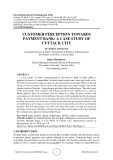
Banking and savings
-
A new model of banks conceptualized by the Reserve Bank of India (RBI) is popularly known as Payment Bank. As these banks cannot issue loans and credit cards, but both current and savings accounts can be operated by such banks. Money is the life blood of every economy.
 8p
8p  guineverehuynh
guineverehuynh
 17-06-2020
17-06-2020
 32
32
 3
3
 Download
Download
-
Almost 50 graduates and post-graduates completed a questionnaire on their sources of personal income (pocket money/allowance, part-time job, gifts), as well as how much they had saved, where it was stored, and for what purpose it was intended. Particular attention was paid to bank accounts.
 5p
5p  guineverehuynh
guineverehuynh
 21-06-2020
21-06-2020
 17
17
 3
3
 Download
Download
CHỦ ĐỀ BẠN MUỐN TÌM















